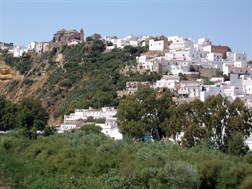The Guadalete river and Arcos de la Frontera
 The centuries of Arab rule on the Iberian Peninsula have left clear traces in the cultural and artistic heritage of Spain. Art and the Baroque taste were often built on the foundations left by the flourishing culture of the invading Muslims, or even in the symbolic places of their history and civilization. Among the many possible examples is the city of Arcos de la Frontera, which is located near the Guadalete River, on the banks of which the famous battle (July 19, 711) that began the Muslim rule on the Iberian peninsula was fought. Arcos, whose current name is derived from the Arabic name Medina Ar-kosch, is characterized, as most of the Andalusian cities, by the presence of various artistic styles, which mirror the different stages of its history. After the Castilian conquest in the thirteenth century, the city soon tied its fate to the Ponce de León family, the Dukes of ArcosThe first Duke of Arcos in history was Rodrigo Ponce de León, who was awarded the title in 1493 by Queen Isabella the Catholic. The Ponce de León held the title for the whole of the Early Modern period, until the death of the childless Antonio Ponce de León y Spínola in 1780 and since then the title has joined the duchy of Osuna. Among the Dukes of Arcos, there was the famous Rodrigo Ponce de León y Álvarez de Toledo (1602-1658), the Viceroy of Naples at the time of the explosion of so-called Masaniello revolt. from the fifteenth century. In the sixteenth and seventeenth centuries it saw a period of prosperity and urban expansion. The church of Santa María de la Asunción (Saint Mary of the Assumption) is a perfect example: the original Mudéjar styleMudéjar art became widespread in the Iberian peninsula after the end of Muslim rule in al-Andalus. It consists in the incorporation of elements of Arabian-inspired style in the new Christian style. The most famous example of Mudéjar art is the Alcázar of Seville., dating from the fourteenth and fifteenth centuries, in fact, gave way to a beautiful Gothic church, in the first half of the sixteenth century, in the exterior of which, however, Renaissance and Baroque elements coexist, especially with regard to the side of the church that overlooks the square of the Chapter house and the huge tower above it. Something similar is seen in the church of San Pedro (Saint Peter), while the church of San Francisco (Saint Francis) retains traces of Baroque art although it was built in the early sixteenth century on an earlier chapel dedicated to Saint Anthony of Padua. The Palacio Mayorazgo, on the contrary, dates back to the seventeenth century in which you can admire the Jardín Andalusí, modeled on the ancient Arab gardens.
The centuries of Arab rule on the Iberian Peninsula have left clear traces in the cultural and artistic heritage of Spain. Art and the Baroque taste were often built on the foundations left by the flourishing culture of the invading Muslims, or even in the symbolic places of their history and civilization. Among the many possible examples is the city of Arcos de la Frontera, which is located near the Guadalete River, on the banks of which the famous battle (July 19, 711) that began the Muslim rule on the Iberian peninsula was fought. Arcos, whose current name is derived from the Arabic name Medina Ar-kosch, is characterized, as most of the Andalusian cities, by the presence of various artistic styles, which mirror the different stages of its history. After the Castilian conquest in the thirteenth century, the city soon tied its fate to the Ponce de León family, the Dukes of ArcosThe first Duke of Arcos in history was Rodrigo Ponce de León, who was awarded the title in 1493 by Queen Isabella the Catholic. The Ponce de León held the title for the whole of the Early Modern period, until the death of the childless Antonio Ponce de León y Spínola in 1780 and since then the title has joined the duchy of Osuna. Among the Dukes of Arcos, there was the famous Rodrigo Ponce de León y Álvarez de Toledo (1602-1658), the Viceroy of Naples at the time of the explosion of so-called Masaniello revolt. from the fifteenth century. In the sixteenth and seventeenth centuries it saw a period of prosperity and urban expansion. The church of Santa María de la Asunción (Saint Mary of the Assumption) is a perfect example: the original Mudéjar styleMudéjar art became widespread in the Iberian peninsula after the end of Muslim rule in al-Andalus. It consists in the incorporation of elements of Arabian-inspired style in the new Christian style. The most famous example of Mudéjar art is the Alcázar of Seville., dating from the fourteenth and fifteenth centuries, in fact, gave way to a beautiful Gothic church, in the first half of the sixteenth century, in the exterior of which, however, Renaissance and Baroque elements coexist, especially with regard to the side of the church that overlooks the square of the Chapter house and the huge tower above it. Something similar is seen in the church of San Pedro (Saint Peter), while the church of San Francisco (Saint Francis) retains traces of Baroque art although it was built in the early sixteenth century on an earlier chapel dedicated to Saint Anthony of Padua. The Palacio Mayorazgo, on the contrary, dates back to the seventeenth century in which you can admire the Jardín Andalusí, modeled on the ancient Arab gardens.
